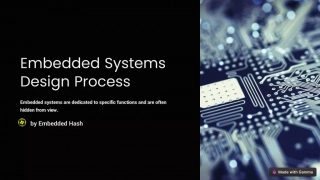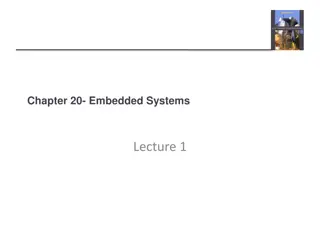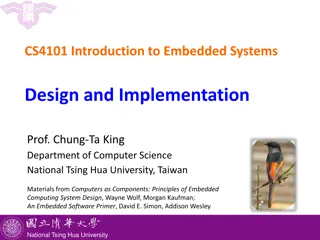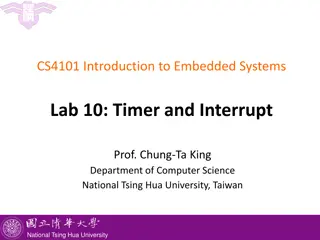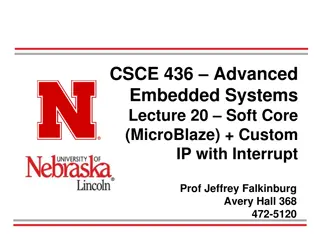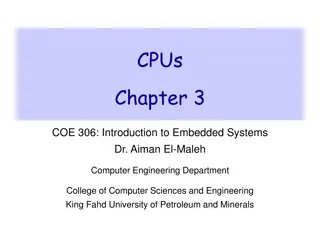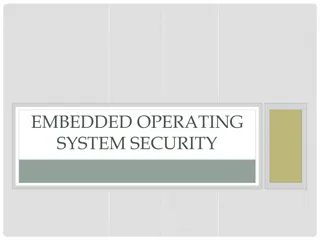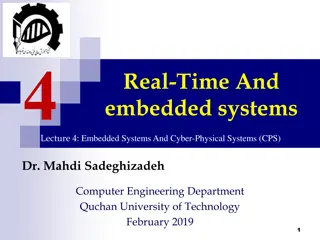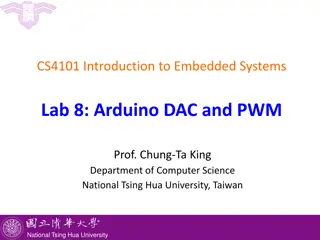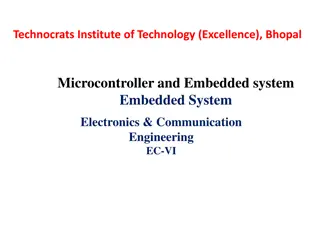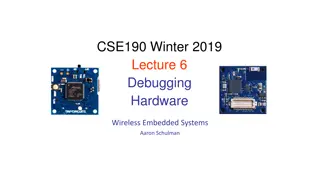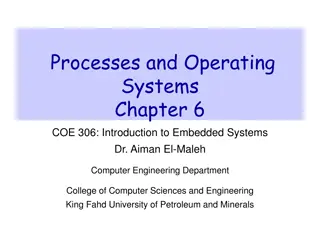
Understanding Real-Time Systems
Dive into the world of real-time systems, where correctness depends not just on computation results but also on timing. Explore applications, examples, properties, and challenges of designing real-time systems in this comprehensive guide.
Download Presentation

Please find below an Image/Link to download the presentation.
The content on the website is provided AS IS for your information and personal use only. It may not be sold, licensed, or shared on other websites without obtaining consent from the author. If you encounter any issues during the download, it is possible that the publisher has removed the file from their server.
You are allowed to download the files provided on this website for personal or commercial use, subject to the condition that they are used lawfully. All files are the property of their respective owners.
The content on the website is provided AS IS for your information and personal use only. It may not be sold, licensed, or shared on other websites without obtaining consent from the author.
E N D
Presentation Transcript
1 Real-Time And embedded systems Lecture 1: Real-Time Systems Dr. Mahdi Sadeghizadeh Computer Engineering Department Quchan University of Technology February 2019 1
Outline Definition of Real-time systems Real-time systems Applications Area Examples of Real-time systems Properties of Real-time systems Time Properties in Real-time systems Classifications of Real-time systems (Types of RTS) Real-time Computing Today Designing a Real-time System What is Difficult about RTS? 2
Real-Time Systems real-time systems are defined as those systems in which the correctness of the system depends not only on the logical result of computation, but also on the time at which the results are produced. A real-time system will usually have to meet many demands within a limited time. 3
Real-Time Systems a real-time system consists of a controlling system (computer) and a controlled system (environment). The controlling system interacts with its environment based on information available about the environment. 4
Examples of Real-Time Systems Real-time systems span a broad spectrum of complexity from very simple micro-controllers to highly sophisticated, complex and distributed systems. Some examples of real-time systems include : Process Control Systems, Flight Control Systems, Flexible Manufacturing Applications, Robotics, Intelligent Highway Systems, High Speed Systems Multimedia Communication Systems Railway Switching Systems Telecommunications Systems 7
Properties of a Real-time System Logical Correctness Strict timing constraints (Timing Correctness) Responsiveness (deadlines), periodicity (sampling rate) Constraints should be verified Application-specific design Embedded systems Carefully specified system properties Well-known operating environment High reliability Thoroughly-tested components High cost of failure Predictable behavior 8
Time Properties Release time (or ready time): Time at which the task is ready for processing. Deadline: Time by which execution of the task should be completed, after the task is released. Minimum delay: Minimum amount of time that must elapse before the execution of the task is started, after the task is released. Maximum delay: Maximum permitted amount of time that elapses before the execution of the task is started, after the task is released. Worst case execution time: Maximum time taken to complete the task. Run time: Time taken without interruption to complete the task, after the task is released. Weight (or priority): Relative urgency of the task. 9
Classifications of Real-time (Types of RTS) soft real-time Systems firm real-time Systems hard real-time Systems 10
Soft Real-time Systems Deadline overruns are tolerable, but not desired. There are no catastrophic consequences of missing one or more deadlines. There is a cost associated to overrunning, but this cost may be abstract. Often connected to Quality-of-Service (QoS) 11
Hard Real-time Systems An overrun in response time leads to potential loss of life and/or big financial damage Many of these systems are considered to be safety critical. Sometimes they are only mission critical, with the mission being very expensive. In general there is a cost function associated with the system. 12
Firm Real-time Systems The computation is obsolete if the job is not finished on time. Cost may be interpreted as loss of revenue. Typical example are forecast systems. 13
Real-time Computing Today? Real-time data processing in cloud! Werner Vogels (Chief technology officer and Vice President of Amazon ) : Theguardian,18 Nov, 2013: Four cloud computing trends for 2014 Cloud will enable your content to follow you wherever you go Cloud based analytics enhances the offline world The cloud allows everyone to become a media company cloud moves data processing to real-time 15
Designing a Real-time System Requirement Specification Implementation Verification 16
Requirement Functional requirements: Operation of the system and their effects. Non-Functional requirements: e.g., timing constraints. F & NF requirements must be precisely defined and together used to construct the specification of the system. Timing constraints A task must complete its execution within given time frames (example: task periodicity or deadline) Exclusion constraints A task must execute a code region without being interrupted (example: a task needs exclusive access to a shared resource) Precedence constraints A task must complete its execution before another task can start (example: a data exchange must take place between the tasks) 17
Specification A specification is a mathematical statement of the properties to be exhibited by a system. It is abstracted such that it can be checked for conformity against the requirement. its properties can be examined independently of the way in which it will be implemented. The usual approaches for specifying computing system behavior entail enumerating events or actions that the system participates in and describing orders in which they can occur. It is not well understood how to extend such approaches for real-time constraints. F18, therac-25 example 18
Implementation Critical choices to be made at design time: Application software: Programming language Determines run-time performance and code size Determines productivity, maintainability and reliability Determines degree of timing verification that is possible Concurrent programming Program is structured as multiple sequential tasks Models the execution of multiple sequential task simultaneously single-processor system: only pseudo-parallel execution possible multiprocessor system: true parallel execution possible 19
Implementation Critical choices to be made at design time: Hardware architecture: Single or multiprocessor architecture Determines degree of true parallelism that can be exploited Microprocessor family RISC processor (pipelines, caches, support for multiprocessors) Micro-controller (no, or very simple, pipelines/caches) Determines cost and run-time performance Determines difficulty in worst-case execution time (WCET) analysis Communication network technology and topology Determines cost, performance and reliability 20
Implementation Critical choices to be made at design time: Run-time system: System services Operating system (real-time kernel with system calls) Stand-alone system (linked library with subroutine calls) Determines run-time performance and code size Determines cost, flexibility and portability Task and message dispatching model Time vs. priority driven dispatching Preemptive vs. non-preemptive dispatching Determines potential of meeting timing constraints Determines processor and network utilization 21
Verification Ad hoc testing: Run the system for a while and let the absence of failures prove the correctness fast method that indicates that everything seems to work pathological cases can be overlooked during testing too frequently used as the only method in industrial design Exhaustive testing: Verify all combinations of input data, time and faults considers all possible cases requires an unreasonable amount of time for testing Formal analysis of the implementation: Verify logical correctness using proof machine requires dedicated description language abstraction level very high (often implementation independent) Verify temporal correctness using schedulability analysis necessary for verifying hard-real-time systems requires WCET for each task requires support in programming language and run-time system 22
What is Difficult about RTS? 1. Concurrency Devices operate in parallel in the real-world Conflicts with sequential execution on controller Hard to maintain deterministic, reproducible behavior 2. Reactive behavior Continuous operation Pace is controlled by environment 3. Guaranteed response times Predictability is essential still efficiency is important Worst case must be predictable Response times on system level 4. Interaction with special purpose hardware Devices must be programmed in a reliable and abstract way Interfaces, device drivers are often a large development-time sink 23
What is Difficult about RTS? Maintenance usually difficult Hardly maintenance loop Instead: First time right 6. Harsh environment Temperature, EMI, radiation, etc. 7. Constrained resources Processing power, memory, power, etc. 8. Often cross development Target platform development platform 9. Size and complexity x100 million lines of code (car, plane) 10. Reliability and safety requirements Embedded systems control the environment in which they operate Control failures can result in enormous damage to environment, to substantial financial loss, or even the loss of human life 24
Thank You 25

